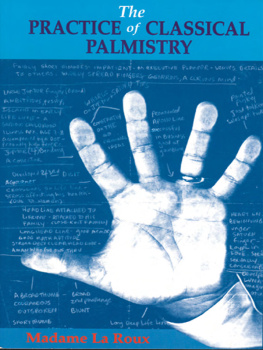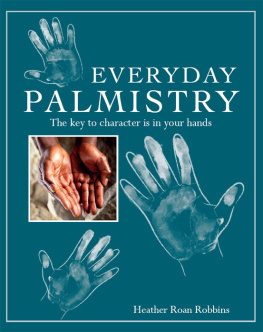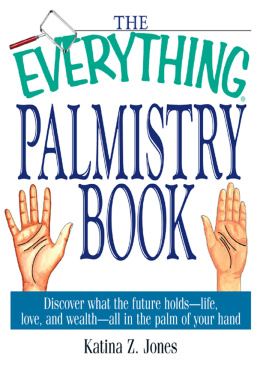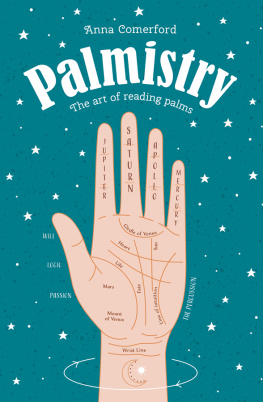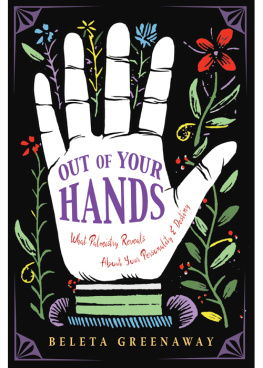PALMISTRY FOR THE BEGINNER
LEARN TO READ YOUR OWN PALMS
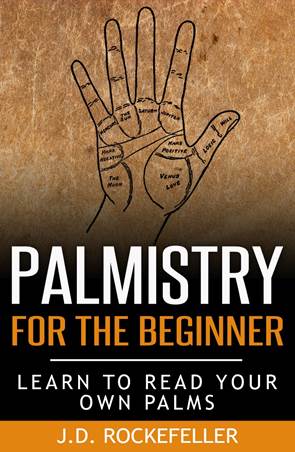
J.D.ROCKEFELLER
~~~
Smashwords Edition
Copyright 2015 by J.D. Rockefeller. All RightsReserved.
No part of this publication may be reproduced,distributed, or transmitted in any form or by any means, includingphotocopying, recording, or other electronic or mechanical methods,or by any information storage and retrieval system without theprior written permission of the publisher, except in the case ofvery brief quotations embodied in critical reviews and certainother non-commercial uses permitted by copyright law.
Smashwords Edition, License Notes
This ebook is licensed for your personal enjoymentonly. This ebook may not be re-sold or given away to other people.If you would like to share this book with another person, pleasepurchase an additional copy for each recipient. If youre readingthis book and did not purchase it, or it was not purchased for youruse only, then please return to your favorite ebook retailer andpurchase your own copy. Thank you for respecting the hard work ofthis author.
Table of Contents
Introduction
If you have a deep interest in learning aboutpersonality characteristics as well as the past and future of aperson, learn to read palms.
Palmistry has been around for centuries andit is practiced in some form or the other in almost all parts ofthe world. Palmistry is also known as chiromancy. The word has beenderived from the sobriquet of a pivotal figure in palm reading,Cheiro (real name: Irish William John Warner).
Cheiro evaluated the persons character andgained insights about his future life just by reading the variouslines and mounts of the palm, the shape and size of the hands andfingers, the texture and color of the skin, the flexibility of thehand, and various other features.
Since then, palmistry has attracted millionsof people around the world. Some learned to use it professionally;others just learned it for fun.
So, are you interested in learning aboutpalmistry, but have no idea where to start? If thats the case, thesolution is right here. The study of palmistry is quitecomprehensive, but here you will be able to learn where to begin,and which are the most important aspects that you need to consider.So, lets get started!

Chapter1 - Which hand Right or Left?
Lets first start by taking a look at thebasics involved in palm reading.
Palmists vary on which hand should be read orwhich one gives the most accurate insight into a persons characterand future. Most believe that one should consider the dominant handto find out about the personality traits of an individual as wellas his future.
Traditional palmists believe that this variesdepending on the gender of the person. If its a woman, you shouldbe reading the left hand. If its a man, read his right hand.
Still others believe that both the handsshould be read since the non-dominant hand may also reveal certaincharacteristics or points that the dominant hand doesnt.
There are also other experts who believe thatthe non-dominant hand reveals the traits of a person and thedominant hand shows how he has used these traits in action.
For a beginner, it will be safe to begin withthe dominant hand. Continue reading palms and follow your intuitionabout which hand you should read.

Chapter2 - Important features to study
Lets now take a look at the importantfeatures of the palms that you should study to gain an accuratereading.
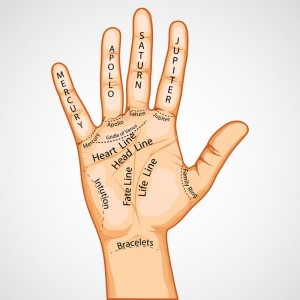
Photo 1: Mounts and line in the palm can reveal a lotabout the person
Color
When you notice the color of the palm, youwill learn about the health of the person. Pinkish color is a goodsign and indicates health. Bluish shows that the person hasproblems related to blood circulation. Yellow indicates excessivebile production.
Texture And Flexibility
Take a look at the texture and flexibility ofboth the front and back of the hand. If it is soft and flexible,the person is sensitive and if it is coarse and stiff, the personhas a rough nature.
Nails
A person with long nails is creative and onewith square-shaped nails is orderly in nature.
Shape Of The Hands
The shape of the hands can reveal a lot aboutthe nature of the person. We will be discussing about the four maintypes in the next chapter.
Mounts
Mounts are the tiny bumps that you see in thepalms. They have their own significance and their color,prominence, and texture can reveal a lot about personal traits. Wewill be discussing about mounts in details in a later chapter.
Lines
Probably the most important features of thepalm, there are three main lines: the line of heart, line of head,and life line. Lines are associated with the mounts located closeto them. There are also other minor lines in the palm besides thesefour main lines. We will be discussing these major and minor linesin later chapters.

Chapter3 - The Different Hand Types
In palmistry, it is believed that the palmstands for the physical body and the fingers stand for the mentalbody.
The traditional system states that there are7 hand types. These are listed below.
Elemental
Square
Spatulate
Philosophical
Artistic
Idealistic
Mixed

The modern system of classification, however,believes that there are 4 main types of hands. These are listedbelow.
Earth Hands or Square Palms
Air Hands or Oblong Palms
Fire Hands or Triangular Palms
Water Hands or Oval Palms

Lets take a further look at these differenthand types.
Earth Hands
These hands have broad and square palms andfingers. The skin is coarse and thick. The length of the palm isequal to the length of the fingers. Known as the physical handtype, these people are practical and responsible, but may bematerialistic and stubborn. These people usually do things theregular way.
Air Hands
These hand types have a square or rectangularpalms with long fingers. The knuckles of the fingers are protrudingand the thumbs are usually set low. The skin is dry. The length ofthe palm is equal to the length of the fingers. Known as the mentalhand type, these people are sociable and witty, but may be spitefuland cold. They like doing things in different ways.










